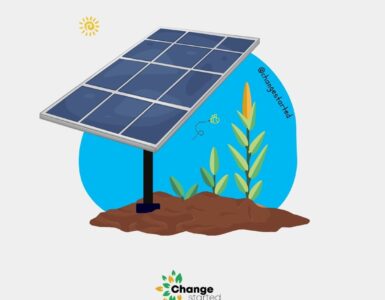2023 has been declared the warmest year since global records began in 1850, with temperatures soaring to 1.18°C (2.12°F) above the 20th-century average – (WMO). In this critical time, we need as many solutions as possible to reduce CO2 and lower the temperature.
According to the EU record, “With around 1.500 billion tonnes of carbon found in the organic matter in soil worldwide, soils are the second largest active store of carbon after the oceans”. The world’s soils (1.500 billion tons) can store twice as much carbon as the atmosphere (760 billion tons), so the potential for carbon sequestration through regenerative agriculture is significant.
While regenerative agriculture presents a beacon for our fight against climate change, its widespread adoption still requires a thorough understanding of its principles.
Understanding Regenerative Agriculture
Regenerative agriculture represents a holistic approach to farming that seeks to restore and enhance the natural systems it relies on. At its core, this sustainable agriculture practice is about creating a harmonious relationship between agriculture and the ecosystems that support it.
Unlike conventional methods, which often deplete natural resources, regenerative agriculture focuses on soil health, water management, and biodiversity, aiming to rebuild organic matter and foster a vibrant ecosystem below and above the ground.
From Tradition to Innovation
The roots of regenerative agriculture lie in traditional farming methods that worked harmoniously with nature long before industrial agriculture became prevalent. Traditional farming techniques that respected the rhythms of nature laid the groundwork for what we now recognize as regenerative practices.
These principles are being refined and expanded with contemporary scientific understanding, offering solutions to some of the most pressing environmental challenges, such as climate change and soil degradation.
Differentiating Regenerative Agriculture from Industrial Methods
Regenerative agriculture and conventional agriculture are fundamentally different in their approaches to farming and their impacts on the environment:
- Soil Health:
🌱 Regenerative agriculture prioritizes soil health, using practices like cover cropping, no-till farming, and composting to enhance soil fertility and structure.
🚧 In contrast, conventional methods often involve intensive tillage and the use of chemical fertilizers, which can lead to soil degradation and erosion.
- Biodiversity:
🌱 By promoting diverse crop rotations and integrating livestock grazing in a managed way, regenerative practices enhance on-farm biodiversity.
🚧 Conventional agriculture tends to rely on monocultures, which can reduce biodiversity and make crops more susceptible to pests and diseases.
- Chemical Use:
🌱 Regenerative agriculture seeks to minimize external inputs, reducing the need for synthetic fertilizers and pesticides.
🚧 Conventional farming heavily relies on harmful chemicals, which can negatively impact soil health, water quality, and surrounding ecosystems.
- Carbon Sequestration:
🌱 A key benefit of regenerative agriculture is its potential to sequester carbon in the soil, helping to mitigate climate change.
🚧 Conventional practices, particularly those involving intensive tillage and high chemical use, can contribute to carbon loss from the soil and higher greenhouse gas emissions.
- Water Management:
🌱 Regenerative practices improve the water cycle within agricultural systems, increasing water infiltration and retention in the soil. This can lead to more resilient crops during drought conditions.
🚧 Conventional methods often result in less efficient water use and greater susceptibility to drought stress.
5 Core Principles of Regenerative Agriculture
1. Soil Health
The cornerstone of regenerative agriculture is the focus on nurturing and restoring the vitality of the soil. Healthy soil forms the foundation for healthy plants, resilient ecosystems, and sustainable farming. By prioritizing the soil, regenerative agriculture practices ensure long-term productivity and environmental health.
Example practices:
- Cover cropping and crop rotation: These practices involve planting various crops in succession or simultaneously to improve soil structure and fertility. For instance, covering crops like mustard and clovers protects the soil from erosion and enhances its nutrient content.
- No-till and minimal tillage practices: These techniques disturb the soil as little as possible, preserving its structure, preventing erosion, and maintaining carbon levels. By avoiding or minimizing tillage, these practices protect soil health and promote a more vibrant ecosystem below the ground.
2. Biodiversity Enhancement
Biodiversity is vital for resilient and productive agricultural systems. By fostering a wide range of plant and animal life, regenerative agriculture creates more stable ecosystems that can withstand pests, diseases, and climate fluctuations.
Example practices:
- Integration of diverse crops and livestock: Mixing crops with livestock and trees, as seen in silvopasture systems, creates a symbiotic environment where each component supports the others, enhancing the overall health of the farm​​.
- Creation of on-farm habitats for beneficial organisms: Incorporating elements of natural ecosystems into farming practices, such as permaculture design, helps to attract beneficial insects and wildlife, which contribute to pollination, pest control, and nutrient cycling​​.
3. Water Conservation
Water is a precious resource, and its efficient use and conservation are paramount in regenerative agriculture. These practices aim to optimize the natural water cycle within agricultural systems, reducing the need for external water sources and mitigating the impact of droughts.
Example practices:
- Efficient water usage strategies: By improving soil structure and cover, regenerative practices enhance the soil’s ability to retain moisture, leading to more efficient water use.
- Rainwater harvesting and conservation practices: Strategies such as maintaining continuous ground cover and employing water-conserving techniques help to capture and retain rainwater, reducing runoff and erosion​​.
4. Community and Social Well-being
Regenerative agriculture recognizes the importance of human communities as part of the ecosystem. It seeks to create farming systems that are environmentally sustainable, socially equitable, and supportive of local economies.
Ensuring fair wages and safe working conditions for farm workers is a key component of regenerative agriculture, promoting social justice and equity in farming communities.

5. Carbon Sequestration
One of the most impactful aspects of regenerative agriculture is its potential to mitigate climate change by sequestering carbon in the soil. Through various practices, regenerative agriculture turns farms into carbon sinks, reducing the overall concentration of greenhouse gasses in the atmosphere.
Techniques such as using biochar and enhancing soil organic matter through composting effectively capture and store carbon in the soil for long periods.
Regenerative agriculture practices can increase carbon sequestration, significantly reducing the agricultural sector’s carbon footprint and contributing to global climate change mitigation efforts.
Wrapping Up
In conclusion, regenerative agriculture represents a profound shift towards a more sustainable and ethical approach to farming that prioritizes the health of our planet and its inhabitants. By implementing the core principles of soil health, biodiversity, water conservation, community well-being, and carbon sequestration, we can create agricultural systems that nourish our bodies and heal the Earth.
The article is written by Bao-Lan Nguyen, the founder and CEO of RegenX, a fintech startup that enables the flow of eco-finance from investors and buyers to farmers transitioning to regenerative farming in Southeast Asia.
Source of featured image: Unsplash






Add comment